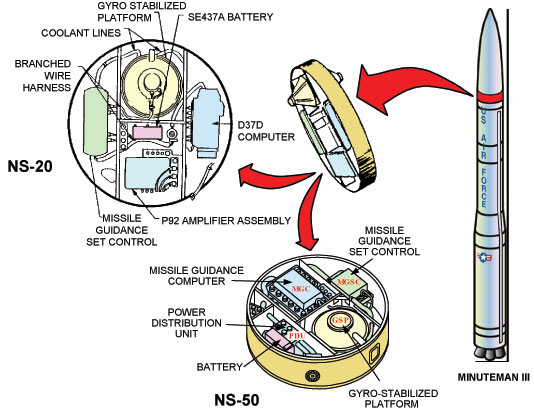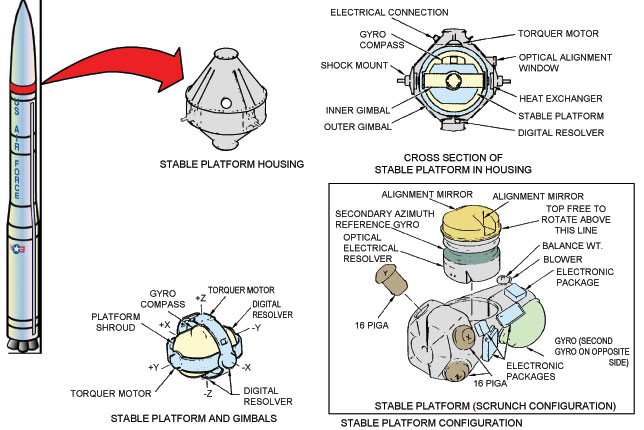Minuteman Guidance System
The Autonetics Division of Rockwell International produced all three generations of the Minuteman Missile Guidance System (MGS) as well as modifications to these systems (the division is now a part of the Boeing Company). The MGS is an inertial guidance system which directs the flight of the missile. The MGS includes the flight computer/amplifier, Gyro Stabilized Platform (GSP), and Missile Guidance Set Control (MGSC), and the Amplifier Assembly. The MGS is an inertial guidance system which directs the flight of the missile. The guidance system operates continuously while the missile is in alert status, thus enabling the missile to be launched in less than one minute.
Once the missile is launched, the guidance system cannot be changed or affected from the ground, a feature which prevents enemy interference with the planned trajectory of the missile.
During first-stage flight, the MGS flight computer sends commands to the nozzle control unit to keep the missile on the precise course required for the reentry vehicles to reach their designated targets. At the proper instant, the computer sends commands which separate an almost exhausted motor from the missile, and ignites the next stage motor. The computer then sends steering commands to the Thrust Vector Control (TVC) Unit of each succeeding motor stage to keep the rocket on course.
The incorporation of current-technology electronics with each generation of the guidance system has resulted in a more capable and less vulnerable system. The NS-50 design developed by Boeing under the Guidance Replacement Program (GRP) will be completely fielded by 2008. The figure below shows the location of the major components in the Minuteman III MGS for the current NS-20 guidance system. The NS-50 design is functionally similar. The colored areas show those items that are being changed by the NS-50 design.
Gyro Stabilized PlatformThe Gyro Stabilized Platform (GSP) measures acceleration and transforms it to velocity which is provided with attitude information to the guidance computer during flight. This data is required so that accurate and proper flight control of the missile is obtained. The GSP also provides level detector and gyrocompass information and accepts control signals so that platform attitude constants are obtained and the platform is properly aligned prior to missile launch.
The Minuteman GSP uses an external gimbal configuration. The platform is stabilized by two dual-axis, free-rotor gyros whose rotors are supported on self-generated gas bearings. One gyro serves as the pitch and roll axis stabilization reference; the other provides an azimuth stabilization reference (the remaining axis is electrically caged).
The dual-axis gas bearing gyro was selected because of its dynamic stability over extended operation periods and its ability to withstand high g loads. Use of self-generated gas bearings means that some wear will take place whenever the G&C section is shut down and restarted. During start-up, a much higher than normal voltage is applied to accelerate the gyro rotors quickly and generate the gas "cushion." Capacitance-type pickoffs are employed to detect displacement of the gyro case relative to the spinning rotor.
The stable platform carries three Pendulous Integrating Gyroscopic Accelerometers (PIGAs) to measure missile acceleration along each of its three axes. Each accelerometer contains a gyroscopic pendulous mass which is floated in liquid to minimize bearing load and friction.
Acceleration along the sensitive axis of an accelerometer displaces its mass, which causes a pickoff to generate a signal. This signal, through closed servoloop mechanization, applies a rotation of the Pendulous Integrating Gyroscope (PIG) sufficient to cause the force on the mass to be countered by precession. The angle through which the PIG has been rotated is proportional to the integrated acceleration (velocity gained and gravity) along the input axis.

Minuteman III Guidance System

Minuteman III Gyro Stabilized Platform